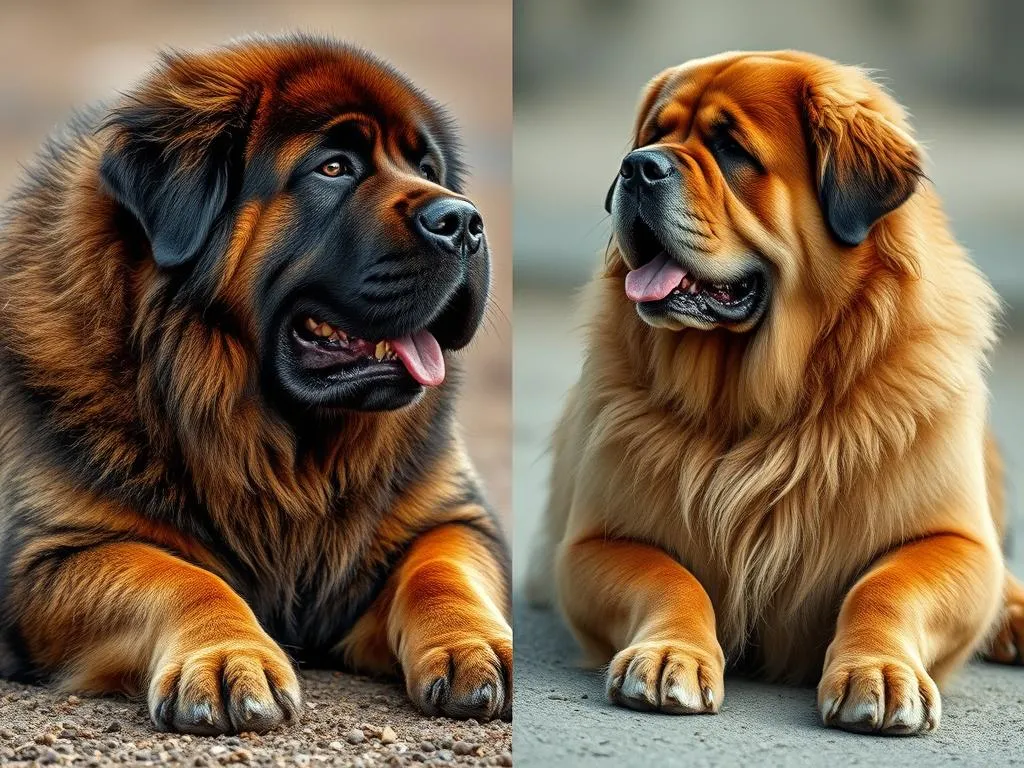
Mastiffs are one of the oldest and most revered dog breeds, known for their size, strength, and protective instincts. Understanding the differences between the various mastiff breeds can help potential dog owners make informed choices. In this article, we will take an in-depth look at two prominent mastiff breeds: the Tibetan Mastiff and the English Mastiff. We will explore their histories, physical characteristics, temperaments, health considerations, training needs, and key differences to help you decide which breed might be the best fit for your lifestyle.
Overview of Mastiff Breeds
Definition of Mastiffs
Mastiffs are large, powerful dogs characterized by their massive bodies and distinctively broad heads. They typically possess a calm demeanor but are also known for their loyalty and protective instincts. Historically, mastiffs have been used for various roles, including guarding homes, protecting livestock, and serving in warfare. Their strength and loyalty make them excellent companions and guardians.
Popular Mastiff Breeds
In addition to the Tibetan Mastiff and English Mastiff, other popular mastiff breeds include the Neapolitan Mastiff and the Bullmastiff. Each breed has its unique traits and characteristics, making them suitable for different types of families and lifestyles. The Tibetan Mastiff, known for its impressive mane and guardian instincts, contrasts sharply with the more gentle and sociable English Mastiff.
Tibetan Mastiff
History and Origin
The Tibetan Mastiff has a rich historical background, originating in the Himalayas over 3,000 years ago. Traditionally, this breed was used by nomadic cultures in Tibet to protect their herds from predators such as wolves and leopards. The Tibetan Mastiff holds significant cultural importance as a guardian dog, symbolizing strength and protection within Tibetan society.
Physical Characteristics
The Tibetan Mastiff is a large breed, with males typically weighing between 90 to 150 pounds, while females usually range from 70 to 120 pounds. They stand about 24 to 30 inches tall at the shoulder. One of their most distinctive features is their thick double coat, which can come in various colors such as black, brown, blue, and gold. Their impressive mane gives them a lion-like appearance and serves as protection against harsh weather conditions.
Temperament and Behavior
Tibetan Mastiffs are known for their independent and strong-willed nature. They are loyal to their families but can be aloof with strangers. This breed is protective and will not hesitate to defend its home and loved ones. While they can be good with children, early socialization is crucial to ensure they are well-adjusted and friendly.
Health Considerations
Common health issues for Tibetan Mastiffs include hip dysplasia, hypothyroidism, and certain eye conditions. Their lifespan typically ranges from 10 to 14 years. Regular veterinary check-ups, a balanced diet, and proper exercise can help mitigate some of these health concerns.
Training and Exercise Needs
Training a Tibetan Mastiff requires patience and consistency due to their independent nature. Positive reinforcement techniques work best. They need regular exercise, including daily walks and playtime in a secure yard, to keep them physically and mentally stimulated.
English Mastiff
History and Origin
The English Mastiff has a long and storied history, tracing its roots back to ancient Rome. These dogs were used in the Roman arena for combat and later as estate guardians in England. Known for their gentle disposition, English Mastiffs have been cherished as companion animals throughout history, symbolizing loyalty and strength.
Physical Characteristics
The English Mastiff is one of the largest dog breeds, with males weighing between 160 to 230 pounds and females ranging from 120 to 170 pounds. They stand around 27 to 32 inches tall at the shoulder. One of their most notable features is their broad head and muscular build, which contribute to their imposing appearance. Their coat is short and comes in various shades of fawn, brindle, and apricot.
Temperament and Behavior
English Mastiffs are known for their calm and gentle temperament. Despite their size, they are good-natured and typically get along well with children and other pets. They are protective of their families but tend to be more sociable than their Tibetan counterparts. Early socialization is essential to promote good behavior and confidence.
Health Considerations
Health issues common in English Mastiffs include hip and elbow dysplasia, heart problems, and certain types of cancer. Their lifespan is generally shorter than that of the Tibetan Mastiff, averaging around 6 to 12 years. Regular health check-ups, a healthy diet, and maintaining a healthy weight are crucial for this breed.
Training and Exercise Needs
Training an English Mastiff is relatively straightforward due to their eagerness to please. They respond well to positive reinforcement and benefit from consistent training sessions. They need moderate exercise, such as daily walks and playtime, to maintain their health without overexertion.
Key Differences Between Tibetan Mastiff and English Mastiff
Size and Appearance
While both breeds are large, the English Mastiff tends to be heavier and bulkier, while the Tibetan Mastiff is more agile with a mane-like coat. The Tibetan Mastiff usually has a more wolf-like appearance due to its facial structure, whereas the English Mastiff has a broad and muscular build.
Temperament and Behavior
The Tibetan Mastiff is more independent and aloof with strangers, making it a superior guardian dog. In contrast, the English Mastiff is sociable and friendly, making it an excellent family companion. Both breeds are protective, but the English Mastiff is generally more welcoming to newcomers.
Health Issues and Lifespan
While both breeds face health issues like hip dysplasia, the English Mastiff is more prone to serious health problems like heart disease. The Tibetan Mastiff tends to have a longer lifespan, averaging 10 to 14 years compared to the English Mastiff’s 6 to 12 years.
Training and Socialization
Training methods differ significantly between the two breeds. The Tibetan Mastiff requires a more experienced handler due to its stubbornness, while the English Mastiff is easier to train and more eager to please. Socialization is critical for both breeds, but the Tibetan Mastiff may need extra effort to ensure it interacts positively with other dogs and strangers.
Choosing the Right Mastiff for You
Considerations Before Choosing
Before selecting a mastiff breed, consider your lifestyle and living situation. The Tibetan Mastiff requires more space and may not be suitable for apartments. In contrast, the English Mastiff, while still large, can adapt better to indoor living as long as it receives adequate exercise.
Pros and Cons of Each Breed
Tibetan Mastiff:
– Pros: Independent, strong guardian instincts, good for experienced owners.
– Cons: Requires significant space, stubborn nature, may be aloof with strangers.
English Mastiff:
– Pros: Gentle temperament, good with children, easier to train.
– Cons: Shorter lifespan, prone to health issues, requires moderate exercise.
Adoption and Breeder Information
When considering bringing a mastiff into your home, it’s essential to adopt from reputable shelters or breeders who prioritize health and temperament. Be sure to ask about health clearances and the dog’s socialization history.
Conclusion
In summary, the Tibetan Mastiff and English Mastiff are both remarkable breeds with unique characteristics. While the Tibetan Mastiff is an independent and fierce protector, the English Mastiff is a gentle giant known for its friendly demeanor. Understanding the differences between these two breeds is crucial for making an informed decision that aligns with your lifestyle and preferences. Whether you choose the steadfast guardian or the affectionate companion, both breeds can bring immense joy and loyalty to your home.
As you contemplate your decision, consider your living situation, family dynamics, and personal preferences. Each breed has its merits, and the right choice will lead to a fulfilling relationship for both you and your new furry friend.









